Abstract
We studied chlorophenol degradation under sulfate-reducing conditions with an estuarine sediment inoculum. These cultures degraded 0.1 mM 2-, 3-, and 4-chlorophenol and 2,4-dichlorophenol within 120 to 220 days, but after refeeding with chlorophenols degradation took place in 40 days or less. Further refeeding greatly enhanced the rate of degradation. Sulfate consumption by the cultures corresponded to the stoichiometric values expected for complete oxidation of the chlorophenol to CO2. Formation of sulfide from sulfate was confirmed with a radiotracer technique. No methane was formed, verifying that sulfate reduction was the electron sink. Addition of molybdate, a specific inhibitor of sulfate reduction, inhibited chlorophenol degradation completely. These results indicate that the chlorophenols were mineralized under sulfidogenic conditions and that substrate oxidation was coupled to sulfate reduction. In acclimated cultures the three monochlorophenol isomers and 2,4-dichlorophenol were degraded at rates of 8 to 37 mumol liter-1 day-1. The relative rates of degradation were 4-chlorophenol greater than 3-chlorophenol greater than 2-chlorophenol, 2,4-dichlorophenol. Sulfidogenic cultures initiated with biomass from an anaerobic bioreactor used in treatment of pulp-bleaching effluents dechlorinated 2,4-dichlorophenol to 4-chlorophenol, which persisted, whereas 2,6-dichlorophenol was sequentially dechlorinated first to 2-chlorophenol and then to phenol.
Full text
PDF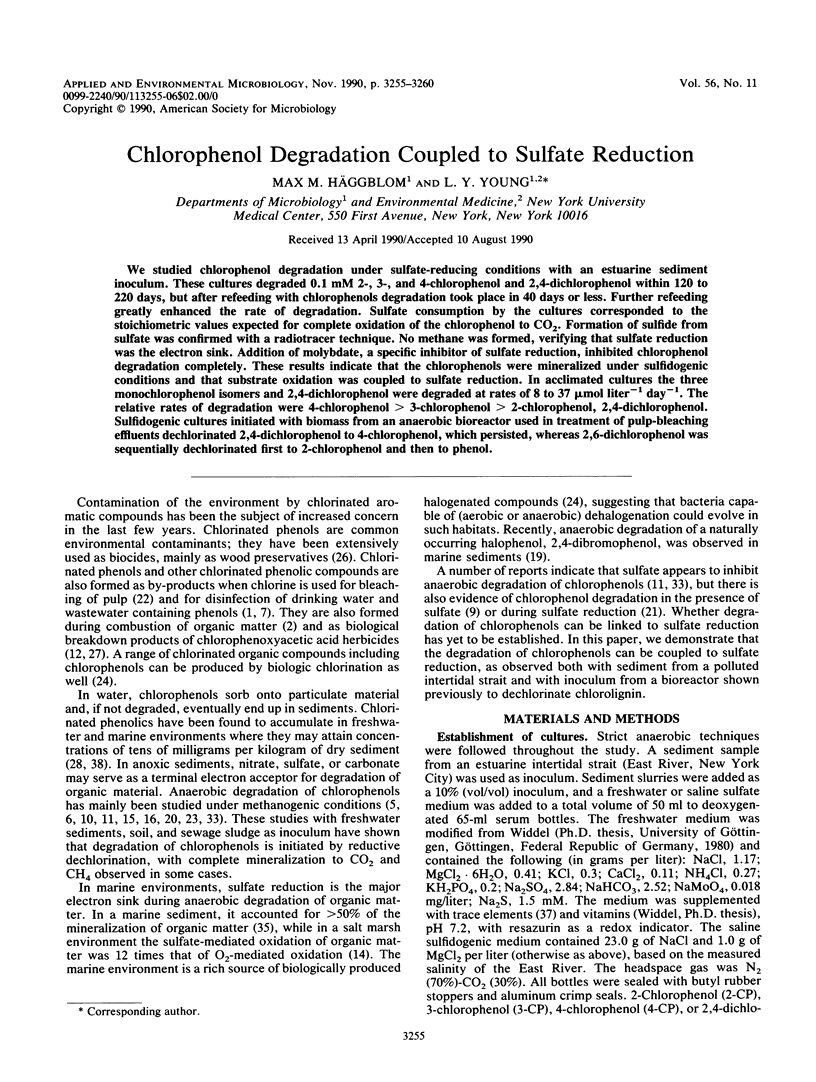
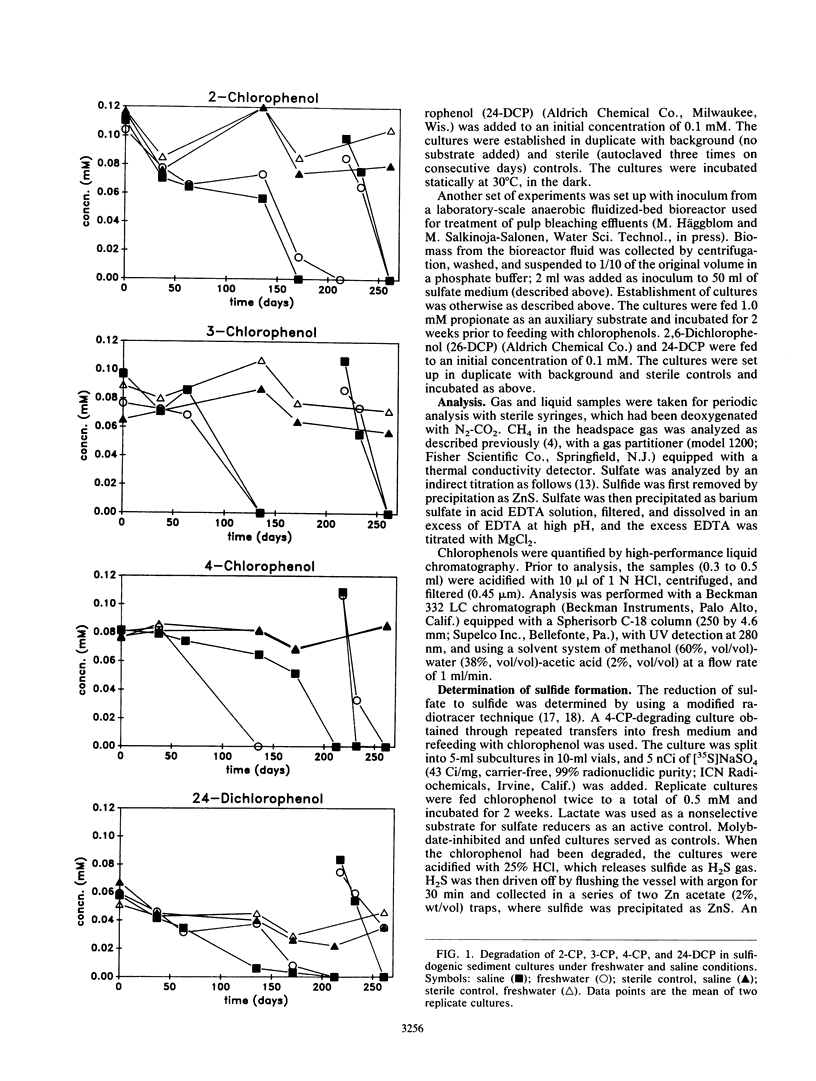
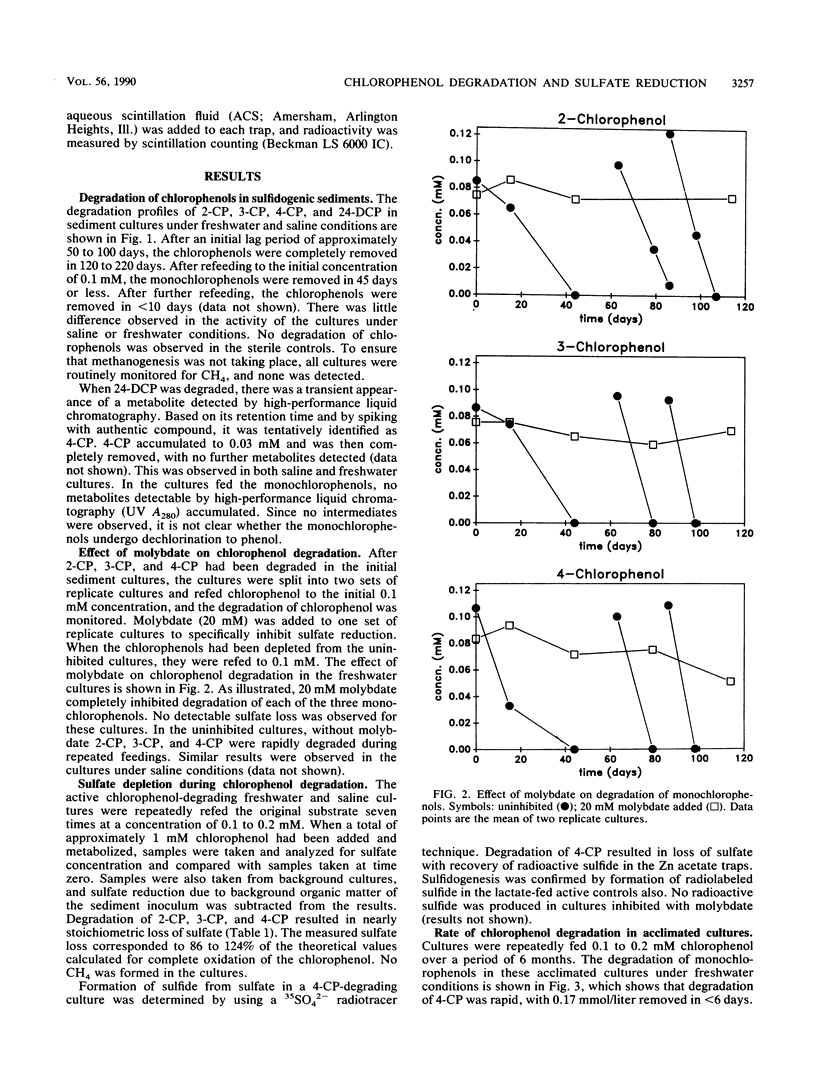
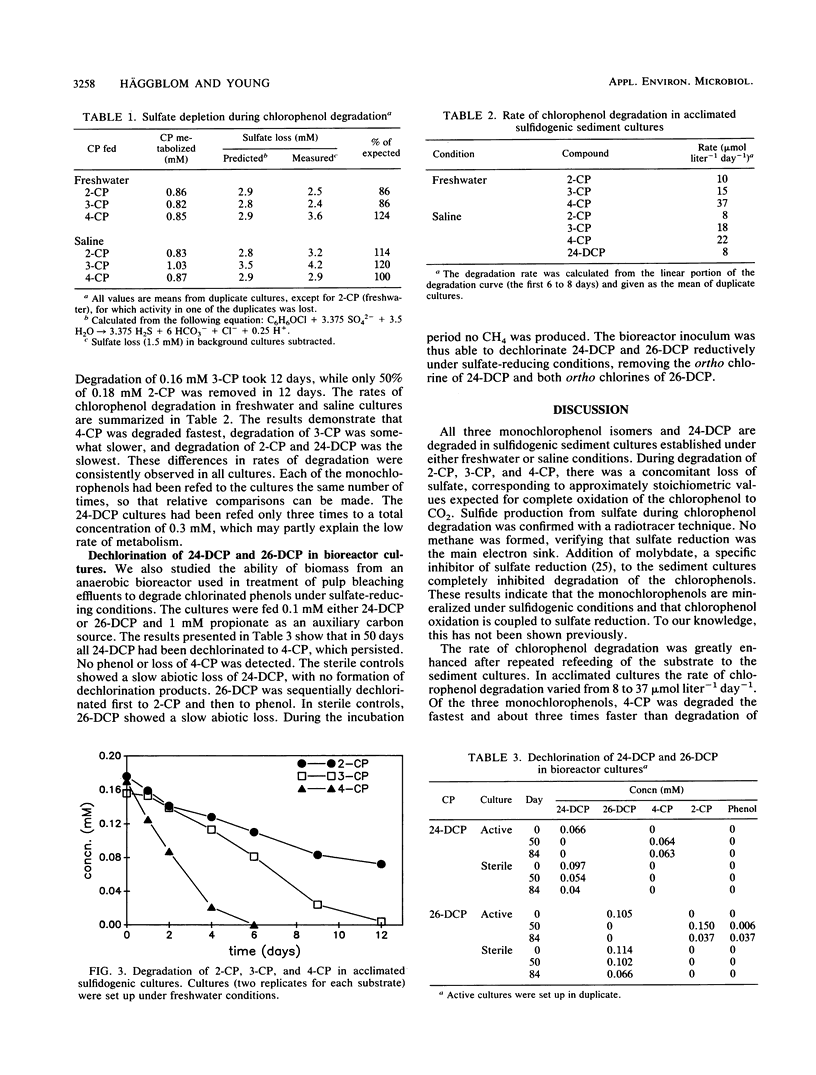
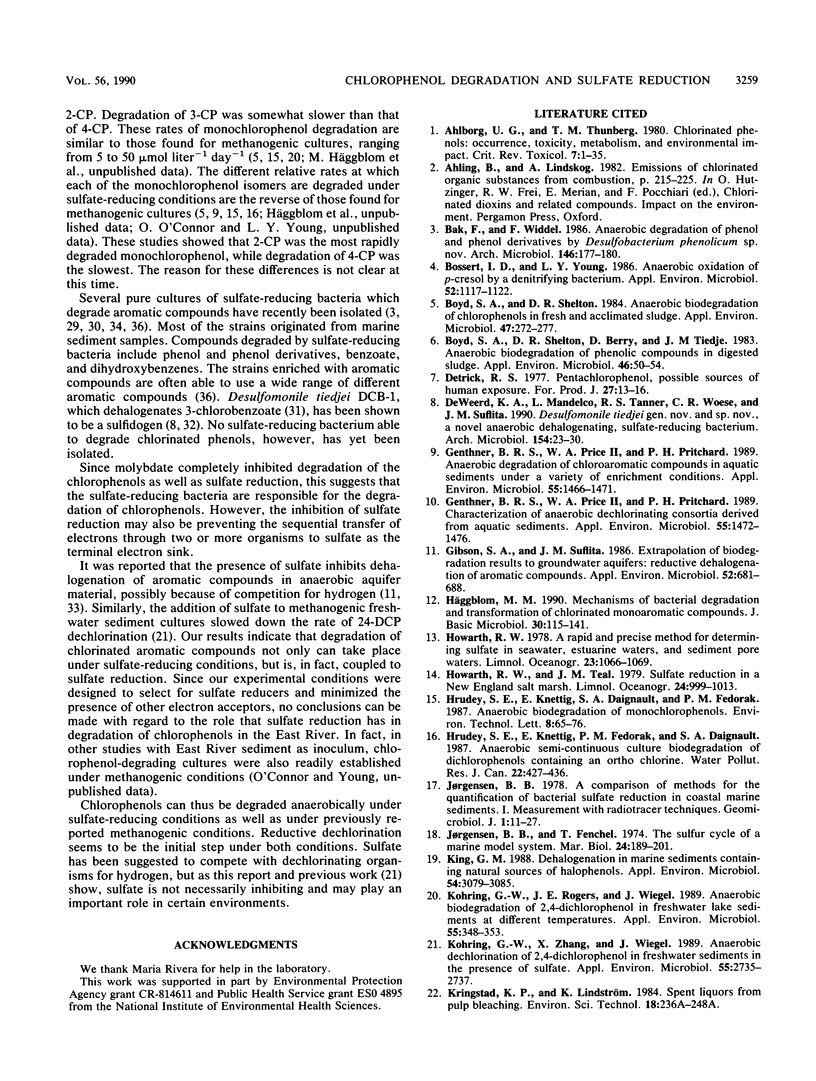
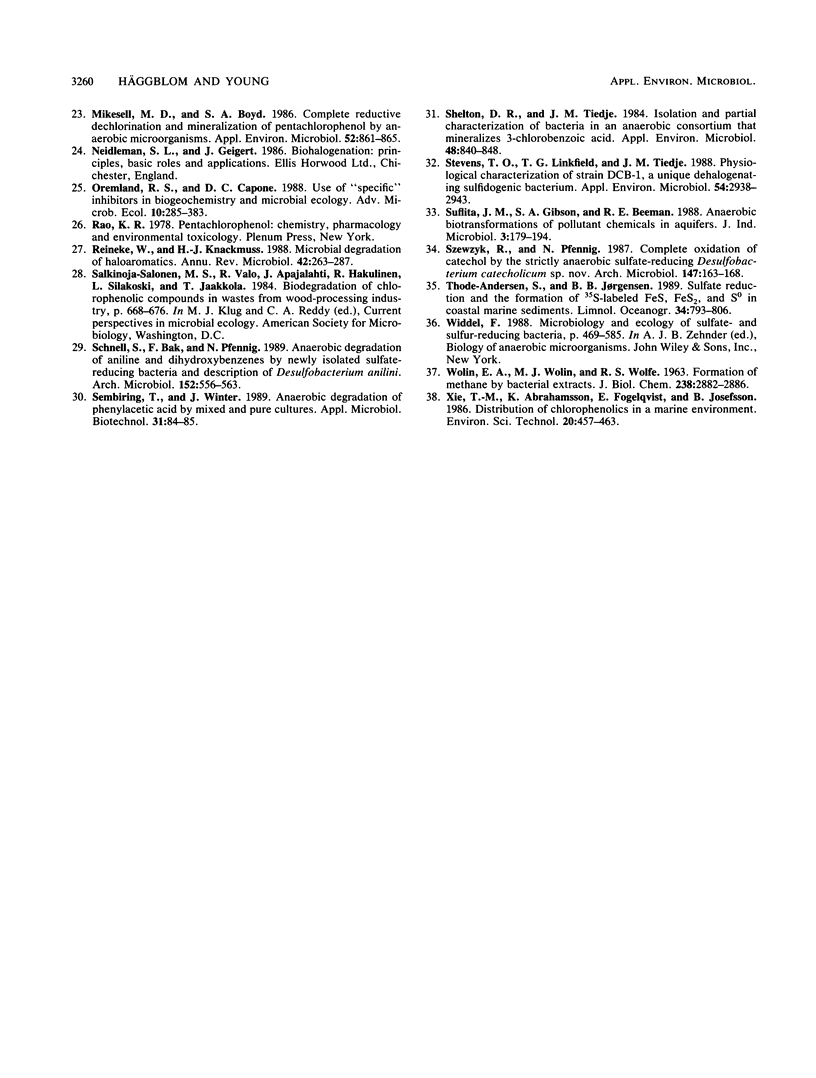
Selected References
These references are in PubMed. This may not be the complete list of references from this article.
- Ahlborg U. G., Thunberg T. M. Chlorinated phenols: occurrence, toxicity, metabolism, and environmental impact. Crit Rev Toxicol. 1980 Jul;7(1):1–35. doi: 10.3109/10408448009017934. [DOI] [PubMed] [Google Scholar]
- Bossert I. D., Young L. Y. Anaerobic oxidation of p-cresol by a denitrifying bacterium. Appl Environ Microbiol. 1986 Nov;52(5):1117–1122. doi: 10.1128/aem.52.5.1117-1122.1986. [DOI] [PMC free article] [PubMed] [Google Scholar]
- Boyd S. A., Shelton D. R. Anaerobic biodegradation of chlorophenols in fresh and acclimated sludge. Appl Environ Microbiol. 1984 Feb;47(2):272–277. doi: 10.1128/aem.47.2.272-277.1984. [DOI] [PMC free article] [PubMed] [Google Scholar]
- Boyd S. A., Shelton D. R., Berry D., Tiedje J. M. Anaerobic biodegradation of phenolic compounds in digested sludge. Appl Environ Microbiol. 1983 Jul;46(1):50–54. doi: 10.1128/aem.46.1.50-54.1983. [DOI] [PMC free article] [PubMed] [Google Scholar]
- Genthner B. R., Price W. A., Pritchard P. H. Anaerobic Degradation of Chloroaromatic Compounds in Aquatic Sediments under a Variety of Enrichment Conditions. Appl Environ Microbiol. 1989 Jun;55(6):1466–1471. doi: 10.1128/aem.55.6.1466-1471.1989. [DOI] [PMC free article] [PubMed] [Google Scholar]
- Genthner B. R., Price W. A., Pritchard P. H. Characterization of anaerobic dechlorinating consortia derived from aquatic sediments. Appl Environ Microbiol. 1989 Jun;55(6):1472–1476. doi: 10.1128/aem.55.6.1472-1476.1989. [DOI] [PMC free article] [PubMed] [Google Scholar]
- Gibson S. A., Suflita J. M. Extrapolation of biodegradation results to groundwater aquifers: reductive dehalogenation of aromatic compounds. Appl Environ Microbiol. 1986 Oct;52(4):681–688. doi: 10.1128/aem.52.4.681-688.1986. [DOI] [PMC free article] [PubMed] [Google Scholar]
- Häggblom M. Mechanisms of bacterial degradation and transformation of chlorinated monoaromatic compounds. J Basic Microbiol. 1990;30(2):115–141. doi: 10.1002/jobm.3620300214. [DOI] [PubMed] [Google Scholar]
- King G. M. Dehalogenation in marine sediments containing natural sources of halophenols. Appl Environ Microbiol. 1988 Dec;54(12):3079–3085. doi: 10.1128/aem.54.12.3079-3085.1988. [DOI] [PMC free article] [PubMed] [Google Scholar]
- Kohring G. W., Rogers J. E., Wiegel J. Anaerobic biodegradation of 2,4-dichlorophenol in freshwater lake sediments at different temperatures. Appl Environ Microbiol. 1989 Feb;55(2):348–353. doi: 10.1128/aem.55.2.348-353.1989. [DOI] [PMC free article] [PubMed] [Google Scholar]
- Kohring G. W., Zhang X. M., Wiegel J. Anaerobic dechlorination of 2,4-dichlorophenol in freshwater sediments in the presence of sulfate. Appl Environ Microbiol. 1989 Oct;55(10):2735–2737. doi: 10.1128/aem.55.10.2735-2737.1989. [DOI] [PMC free article] [PubMed] [Google Scholar]
- Mikesell M. D., Boyd S. A. Complete reductive dechlorination and mineralization of pentachlorophenol by anaerobic microorganisms. Appl Environ Microbiol. 1986 Oct;52(4):861–865. doi: 10.1128/aem.52.4.861-865.1986. [DOI] [PMC free article] [PubMed] [Google Scholar]
- Reineke W., Knackmuss H. J. Microbial degradation of haloaromatics. Annu Rev Microbiol. 1988;42:263–287. doi: 10.1146/annurev.mi.42.100188.001403. [DOI] [PubMed] [Google Scholar]
- Schnell S., Bak F., Pfennig N. Anaerobic degradation of aniline and dihydroxybenzenes by newly isolated sulfate-reducing bacteria and description of Desulfobacterium anilini. Arch Microbiol. 1989;152(6):556–563. doi: 10.1007/BF00425486. [DOI] [PubMed] [Google Scholar]
- Shelton D. R., Tiedje J. M. Isolation and partial characterization of bacteria in an anaerobic consortium that mineralizes 3-chlorobenzoic Acid. Appl Environ Microbiol. 1984 Oct;48(4):840–848. doi: 10.1128/aem.48.4.840-848.1984. [DOI] [PMC free article] [PubMed] [Google Scholar]
- Stevens T. O., Linkfield T. G., Tiedje J. M. Physiological characterization of strain DCB-1, a unique dehalogenating sulfidogenic bacterium. Appl Environ Microbiol. 1988 Dec;54(12):2938–2943. doi: 10.1128/aem.54.12.2938-2943.1988. [DOI] [PMC free article] [PubMed] [Google Scholar]
- WOLIN E. A., WOLIN M. J., WOLFE R. S. FORMATION OF METHANE BY BACTERIAL EXTRACTS. J Biol Chem. 1963 Aug;238:2882–2886. [PubMed] [Google Scholar]


